Delicious, tender and moist oven roasted turkey breast flavored with orange and rosemary. This go-to recipe for roasting a bone-in turkey breast is easy, foolproof, and always delicious! If you’re cooking for a smaller crew this holiday season, a roast turkey breast is a great option as it cooks quicker and serves eight.
Whether you’re cooking for less, or simply want a less stressful Thanksgiving, a roasted bone-in turkey breast is a great alternative to a whole bird. Aside from cooking faster, it also cooks more evenly. Without the wings, thighs, and legs, the breast cooks more evenly and can be pulled right when it’s done, meaning it won’t dry out while the dark meat finishes cooking.
Table of Contents
- What is a Brine?
- Benefits of Brining a Turkey Breast
- How to Prepare a Bone-In Turkey Breast for Roasting
- How To Brine a Turkey Breast
- Use The Drippings for Gravy
- What Temperature Should a Turkey Breast Be Cooked To?
- How to Carve a Bone-In Turkey Breast
- How to Freeze Leftover Turkey
- Serving
- Leftover Turkey Recipes
- Orange Glazed Oven Roasted Turkey Breast Recipe
What is a Brine?
Brining is a great technique to use which helps to ensure a moist roast turkey breast. Brining is an age-old technique used for tenderizing, flavoring, and reducing cooking times of foods.
At its simplest, a brine is a solution of salt and water that is used for pickling, preserving or tenderizing food. Other flavorings such as herbs, spices and sugar are also often added to the solution. For this roast turkey breast recipe, I infuse the brine with rosemary, bay leaves, garlic, and orange juice concentrate.
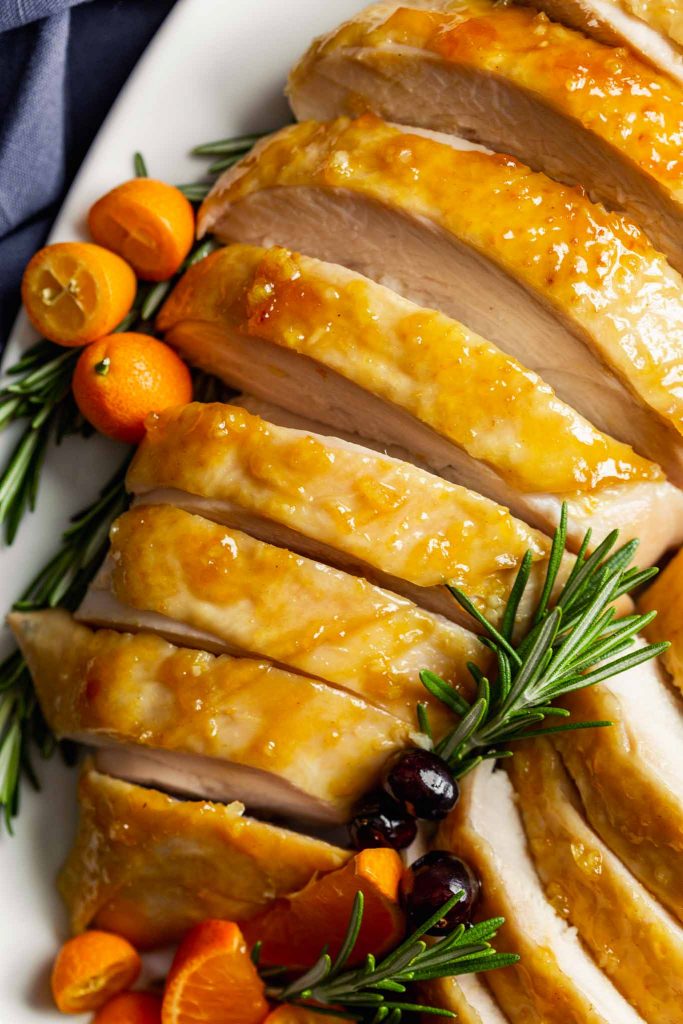
Benefits of Brining a Turkey Breast
There are many benefits to brining meat, but in this instance we’re using a brine to tenderize, moisturize and flavor our turkey breast. Additionally, it also cuts down on the cooking time, which makes timing and cooking the Thanksgiving meal easier.
The only precaution is to make sure the word “pre-brined” is not printed on your turkey breast packaging. Butterball turkey breasts, for instance, come pre-brined and would be too salty if they were brined a second time. If all you can find is a pre-brined turkey breast, skip the brining process and move on to roasting.
For this recipe we’re keeping our brine easy, yet flavorful. Our solution consists of water, salt, brown sugar, orange juice concentrate, black peppercorns, dried bay leaves, and garlic cloves. Orange juice is often used in meat marinades because it’s acidic and acts as a tenderizing agent.
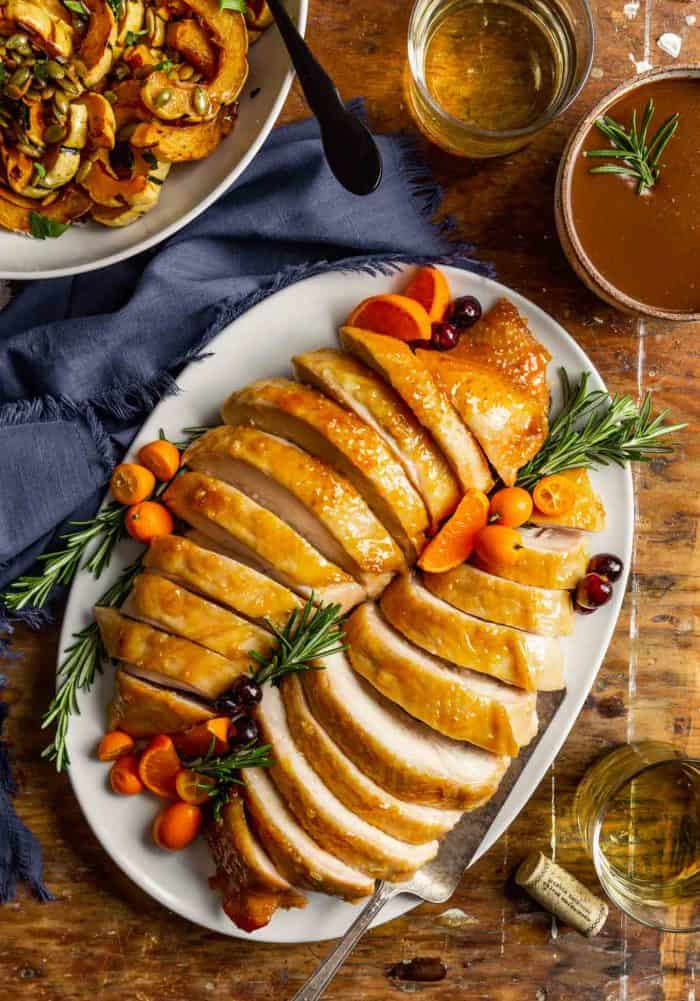
How to Prepare a Bone-In Turkey Breast for Roasting
To ensure even cooking, it’s important to remove the back from the turkey breast. The process is pretty straight forward, but it does require some attention. If you’d rather not cut out the back yourself, ask your butcher to do it, more often than not they’re happy to help!
If you’re ready to do it yourself, I’ll walk you through it step-by-step!
- Place turkey breast on a cutting board skin side down.
- Using kitchen shears, cut through ribs, following the vertical line of fat where breast meets back, from tapered end of breast to wing joint. You’ll need a bit of hand strength here and sharp kitchen shears!
- Using your hands, bend the back away from the breast to pop the shoulder joints out of the sockets.
- Using a paring knife, cut through the joints between the bones to separate back from breast.
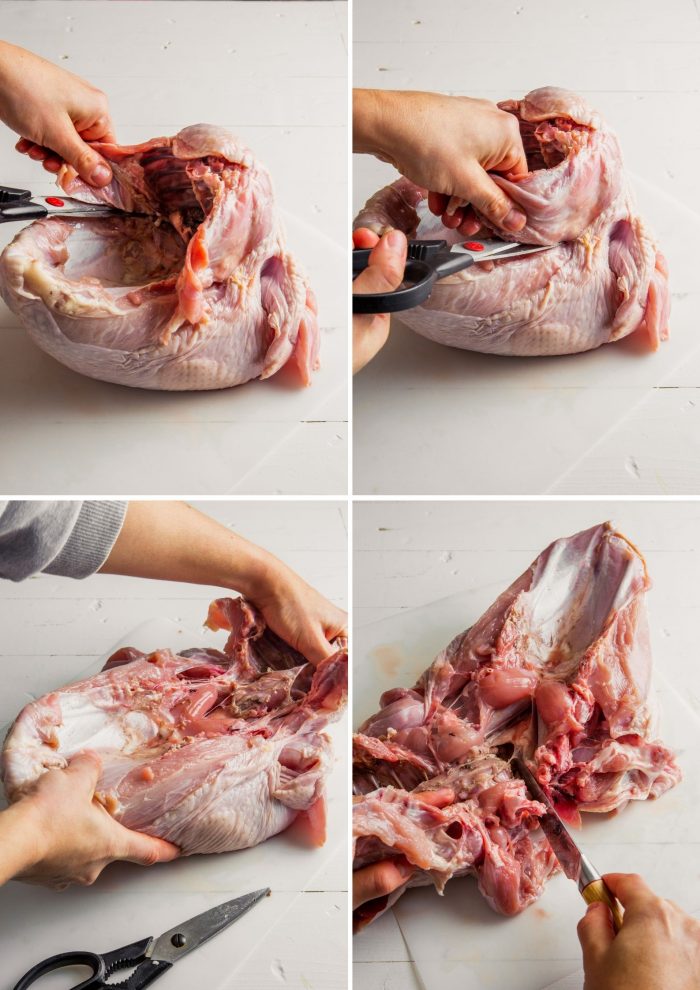
How To Brine a Turkey Breast
First, you’ve got to make the brine. No worries, it’s quick! Combine the water, salt, sugar and flavorings in a large pot. Bring the mixture to a boil and simmer until the salt and sugar have dissolved.
Remove the brine from heat and let it cool completely—I recommend adding some ice after a while to speed up the process.
Meanwhile, prep the breast by cutting through the ribs and removing the back.
Once the brine is cooled completely, drop the turkey breast in the brine, cover and refrigerate at least two hours or up to overnight. I find eight hours to be the sweet spot.
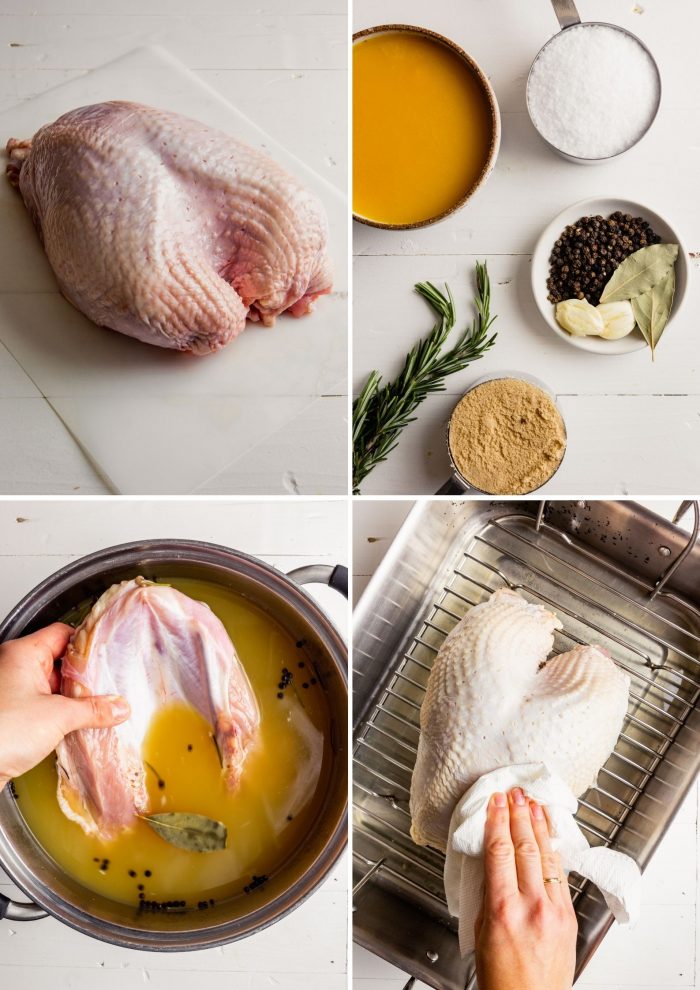
Use The Drippings for Gravy
An oven roasted turkey breast doesn’t render as many drippings as a whole bird, which makes whipping up a gravy a bit harder.
Fortunately, the combination of the drippings, excess glaze dripping from the breast, and the added wine create a wonderful base for a pan gravy.
The drippings will start to burn during roasting—which is to be expected. Those burned bits add depth of flavor to the gravy, however the flavor can be intense. If you like a more mild-flavored gravy, add a cup of broth or water to the roasting pan halfway through roasting.
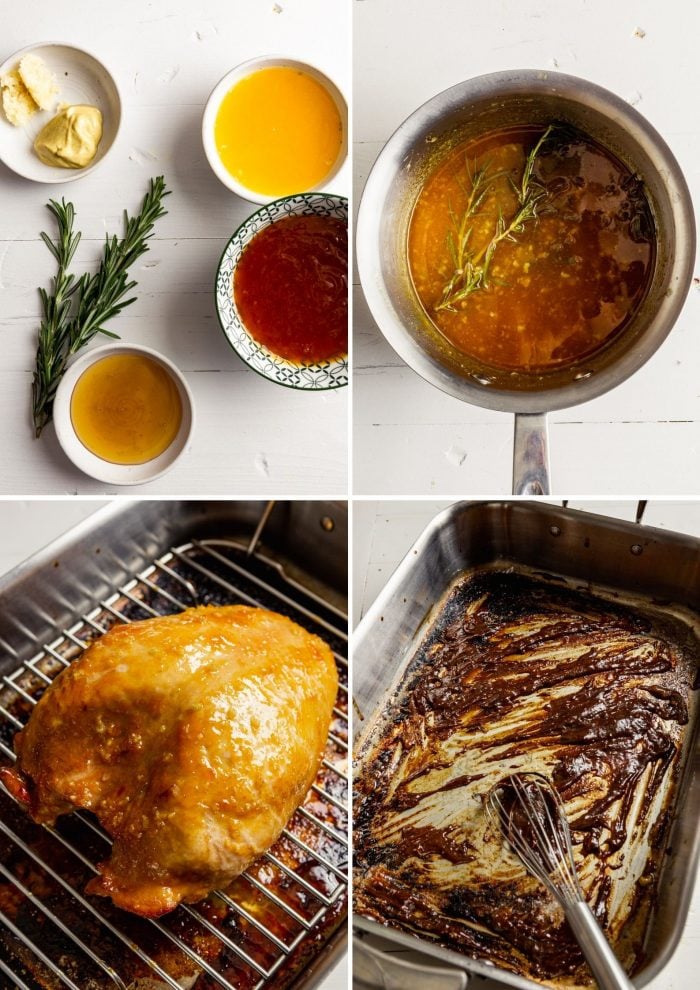
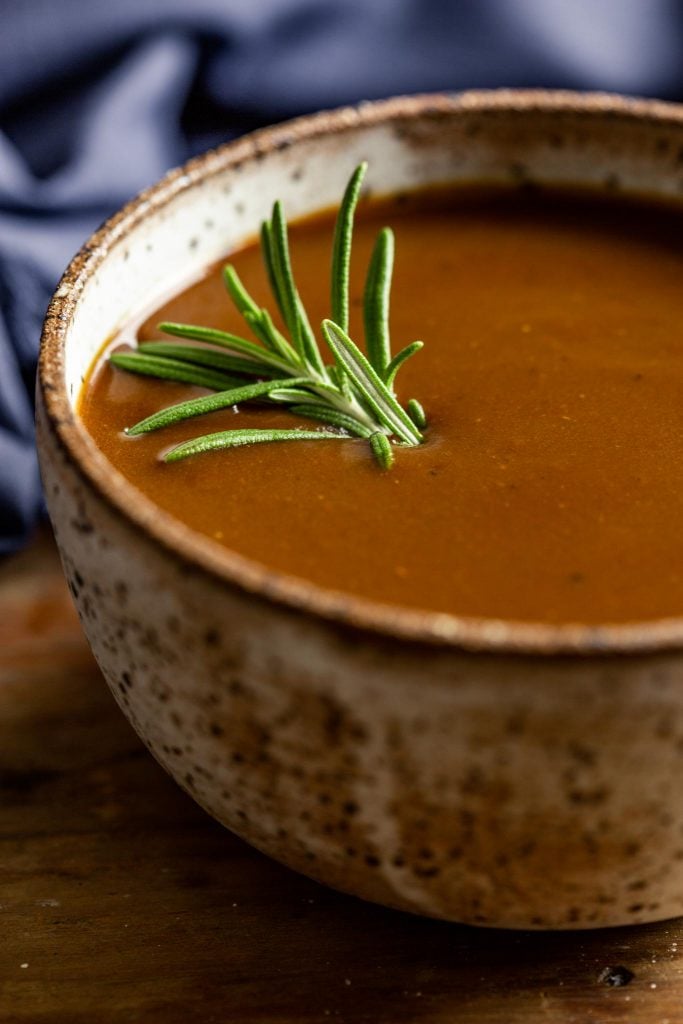
What Temperature Should a Turkey Breast Be Cooked To?
For the safest, and best quality, cook a bone-in turkey breast to 165°F.
Temperature is arguably the most important step in cooking the perfect Thanksgiving turkey breast. In general, when it comes to cooking any kind of meat, temperature is essential. Plus, why guess when you can accurately test the temp of your turkey in just seconds?
Yes, checking the temperature of your meat is immensely important for food safety reasons. But beyond that, checking the temperature of your meat while cooking helps to ensure that it’s cooked, but not over cooked. And that’s key to making a turkey breast that’s moist and delicious.
In my humble opinion, gone are the days of using meat thermometers with thick probes and clunky designs. My favorite thermometer is one that reads in 1–2 seconds, has an accuracy of 0.7°F and is efficiently designed.
If you’re in the market for a new kitchen thermometer, don’t waste your time on cheap, mass-produced models. Opt for the Thermapen from ThermoWorks. Use it once and you’ll see why it’s worth every penny.
I’ve worked in countless test kitchens, and this is the one kitchen tool that is universally used by them all. It’s accurate, easy to use and best of all—buy it once and you’ll probably have it for life.
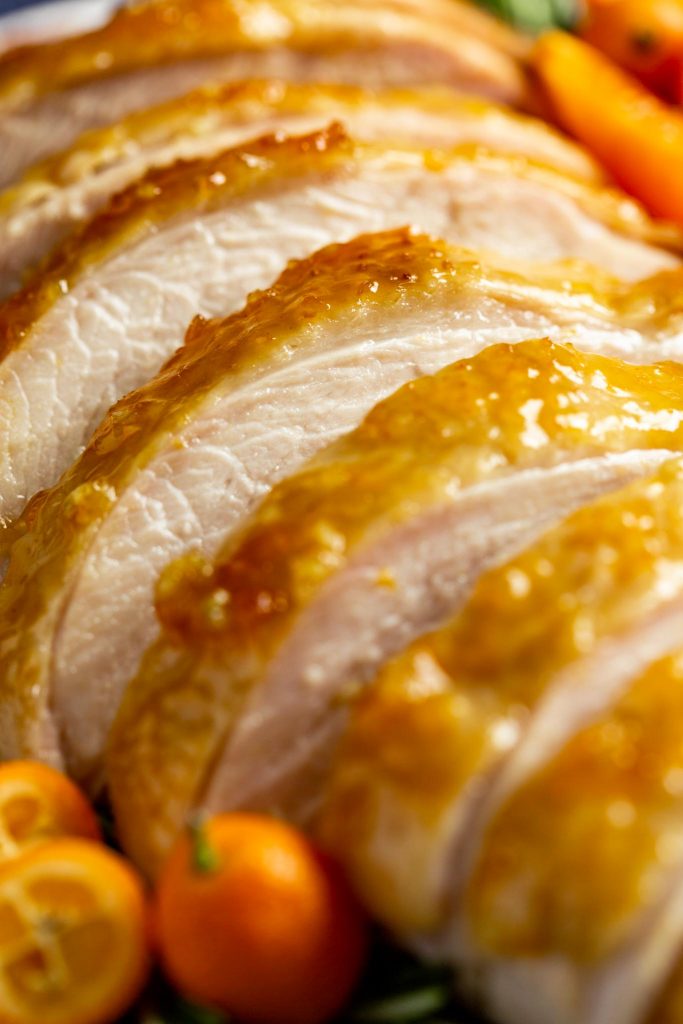
How to Carve a Bone-In Turkey Breast
Use your finger to locate the breast bone in the center of the breast.
Run a knife down one side of the breast bone, all the way through the meat. Then, gently pull the whole breast off. Repeat with the second side, then cut into 3/4- to 1-inch slices.
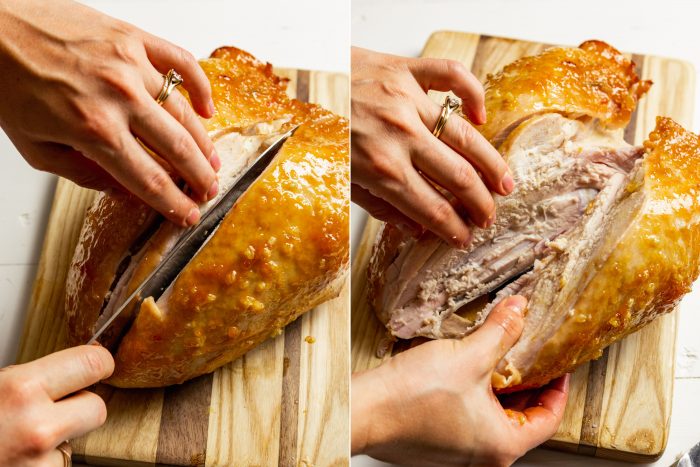
How to Freeze Leftover Turkey
Leftovers are one of the joys of Thanksgiving. The best way to freeze leftover turkey is to take all of the meat off of the bones and transfer to a resealable freezer bag. Press the air out , seal and place in a second resealable freezer bag.
Why double bag? It will help protect your flavorful meat from getting freezer burn.
Alternatively, if you don’t want to freeze all of the leftovers in one big bag, you can divide them into 1–2 serving size portions and freeze in smaller bags. This way, you can thaw and enjoy your turkey over the course of a few months.
Thaw frozen cooked turkey in the refrigerator overnight.
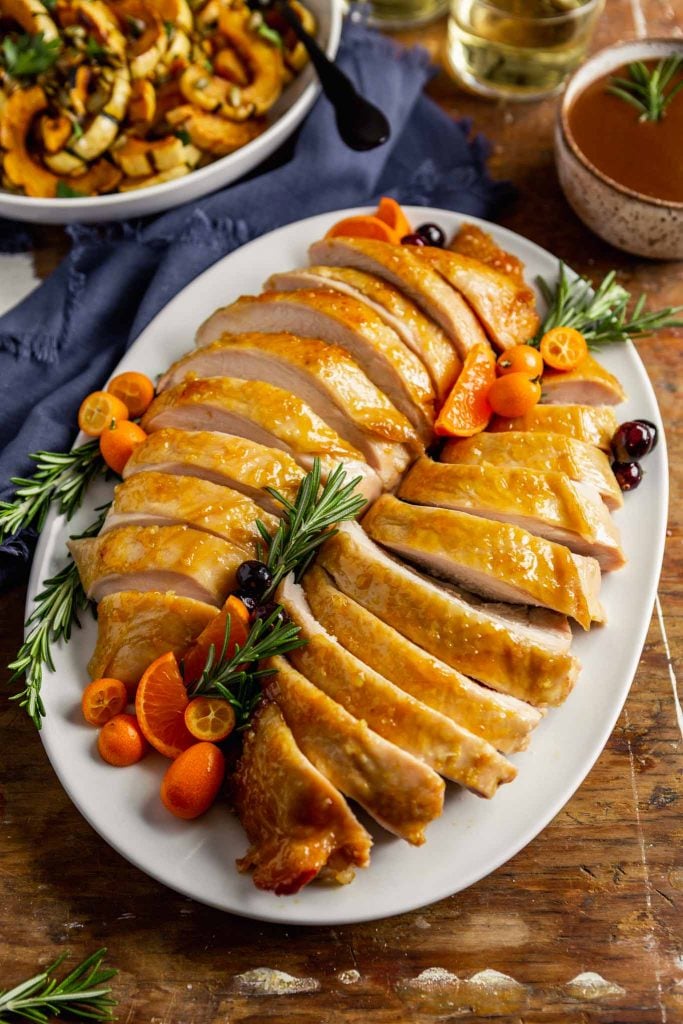
Serving
- Red wine: Pinot Noir, Merlot, Syrah or Zinfandel. If you’re trying to impress opt for a Beaujolais.
- White wine: choose wines that are acidic and crisp such as Sauvignon Blanc, a dry Riesling Voignier, or an unoaked Chardonnay.
- Roasted Delicata Squash with Maple Browned Butter Sauce
- Caesar Roast Brussels Sprouts
- Mashed Celery Root and Potatoes
- Wild Mushroom Stuffing
- Easy Roasted Green Beans
- Milk Bread Rolls
- Pumpkin Challah Rolls
- Pumpkin Mashed Potatoes
Leftover Turkey Recipes
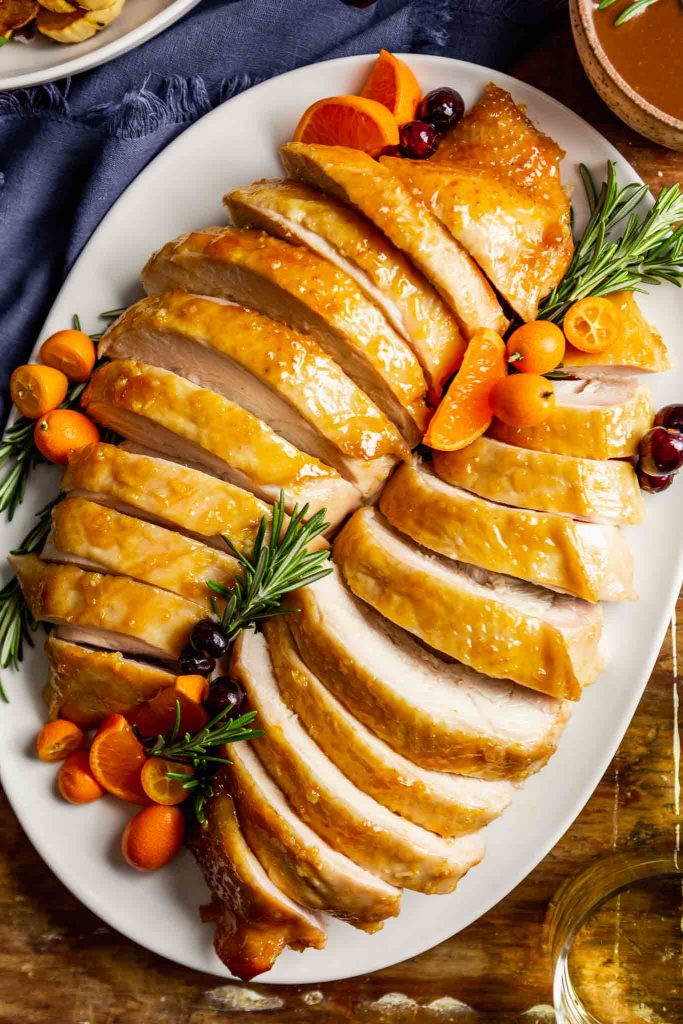
Orange Glazed Oven Roasted Turkey Breast
Description
Ingredients
Brine
- 3 quarts water (12 cups)
- 12 ounces frozen 100% orange juice concentrate
- ¾ cup Morton kosher salt
- ½ cup packed brown sugar
- 2 sprigs fresh rosemary
- 2 tablespoons black peppercorns
- 2 dried bay leaves
- 2 cloves garlic, smashed
- 4 cups ice cubes
- 1 bone-in turkey breast (6–8 pounds)
Glaze
- ½ cup apricot preserves, or sweet orange marmalade
- ¼ cup fresh orange juice
- 2 tablespoons honey
- 1 tablespoon Dijon mustard
- 2 teaspoon minced fresh garlic
- 2 sprigs fresh rosemary
Roasting
- 1 cup dry white wine or low-sodium chicken broth
Gravy:
- ⅓ cup white whole-wheat flour, or all-purpose flour
- 5 cups low-sodium chicken broth
- 1 tablespoons apple cider vinegar
Instructions
Brine
- Heat water, orange juice concentrate, salt, brown sugar, rosemary, peppercorns, bay leaves, and garlic in a pot over medium to a boil. Cover pot and remove from heat; let cool 20 minutes. Stir in ice until melted; let cool 10 minutes more.
- Place turkey breast on a cutting board skin side down. Using kitchen shears, cut through ribs, following vertical line of fat where breast meets back, from tapered end of breast to wing joint. Using your hands, bend back away from breast to pop shoulder joints out of sockets. Using paring knife, cut through joints between bones to separate back from breast.
- Submerge breast in brine, cover pot, and refrigerate until ready to roast, at least 2 hours, or up to overnight.
Glaze
- Combine preserves, orange juice, honey, Dijon, garlic, and rosemary in a saucepan over medium heat. Bring glaze to a boil, then remove from heat and let cool completely then discard rosemary sprigs.
Roasting
- Preheat oven to 425°. Place a rack inside a roasting pan and coat rack with nonstick spray.
- Remove breast from brine, rinse and pat dry well.
- Place breast skin side up on rack and pour wine into bottom of pan.
- Roast breast 30 minutes, rotate pan, reduce temperature to 325°, then brush breast with glaze. Roast Breast until a thermometer inserted into the thickest part registers 165°F, about 1 ½ hours more, brushing with glaze every 30 minutes until all glaze is used.
- Transfer breast to a cutting board, tent with foil, and let rest 20 minutes before slicing. Reserve drippings in pan for the gravy.
Gravy
- Heat drippings in roasting pan over medium.
- Whisk in flour and cook, whisking constantly, 2 minutes. Slowly whisk in chicken broth.
- Bring gravy to a simmer over high, reduce to medium-high and simmer, whisking constantly, until thickened, 10–15 minutes. Off heat, stir in vinegar. Strain gravy through a fine-mesh sieve; keep warm until ready to serve.
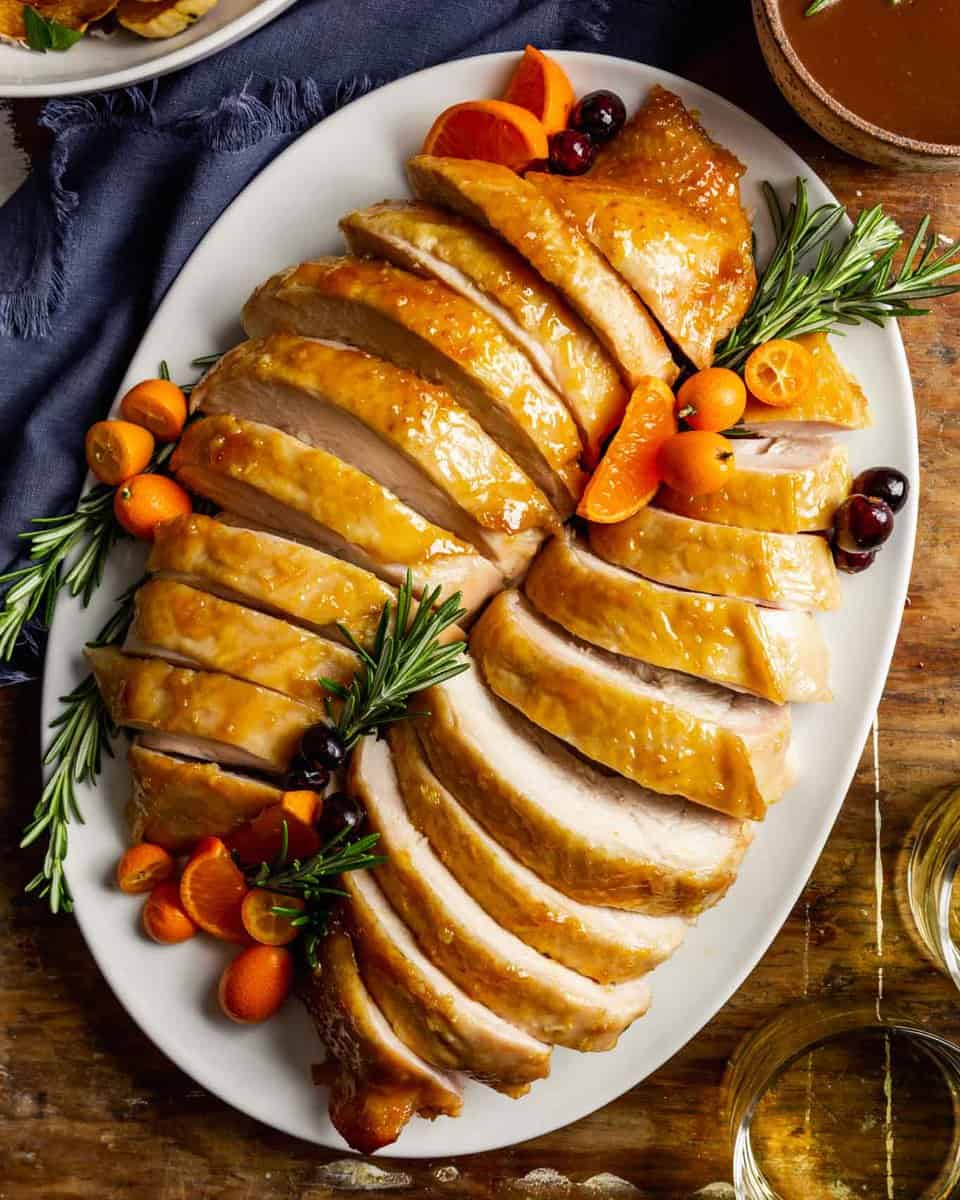
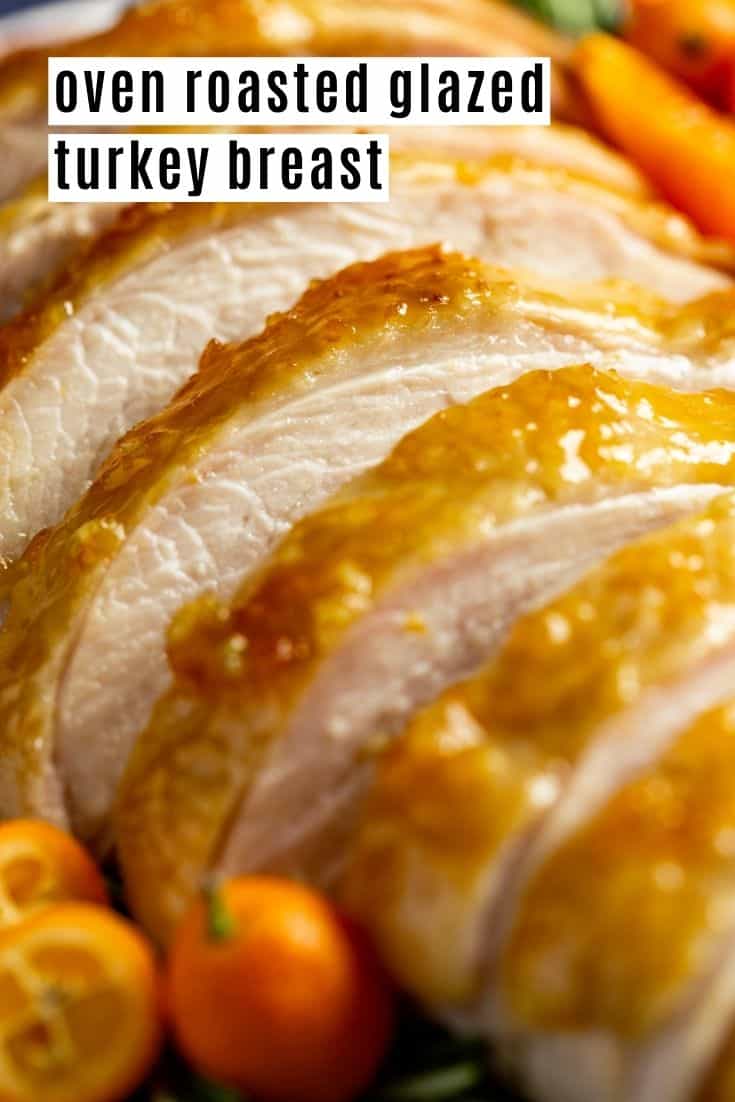
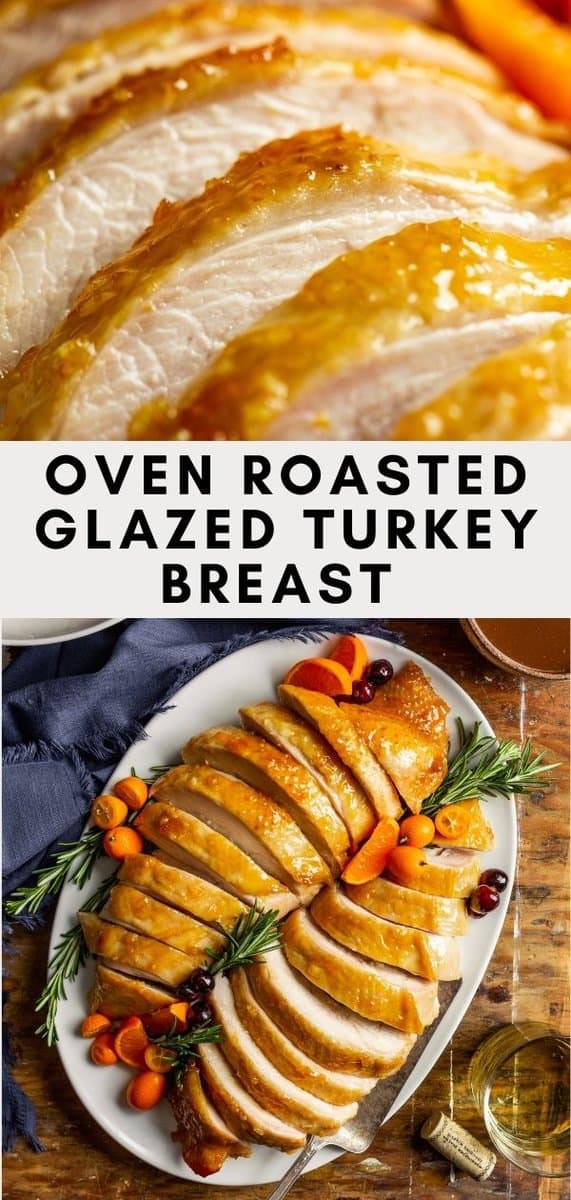
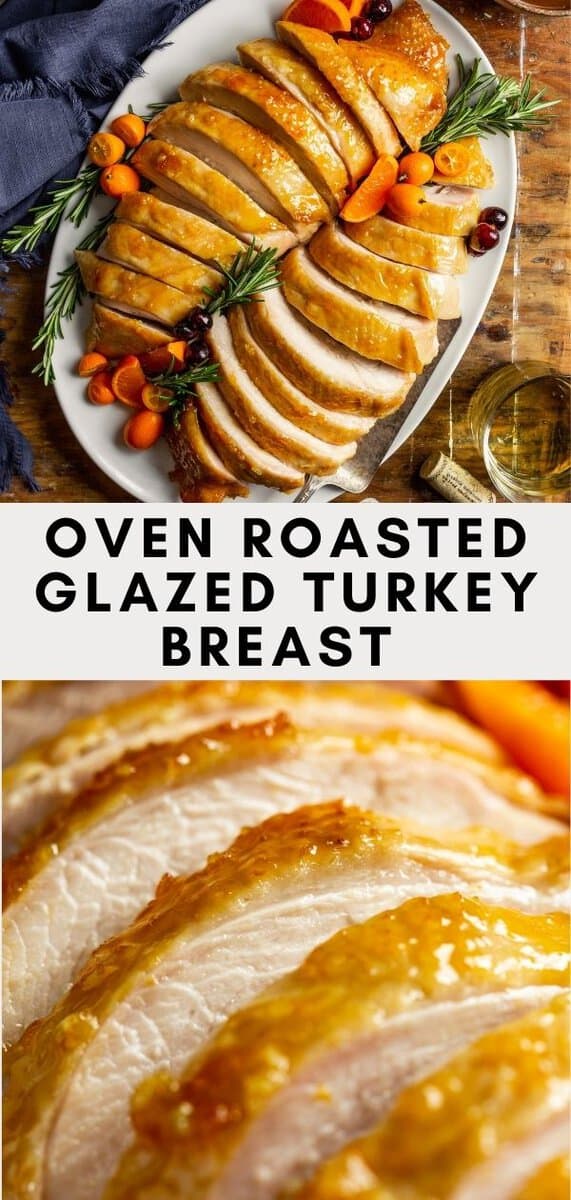
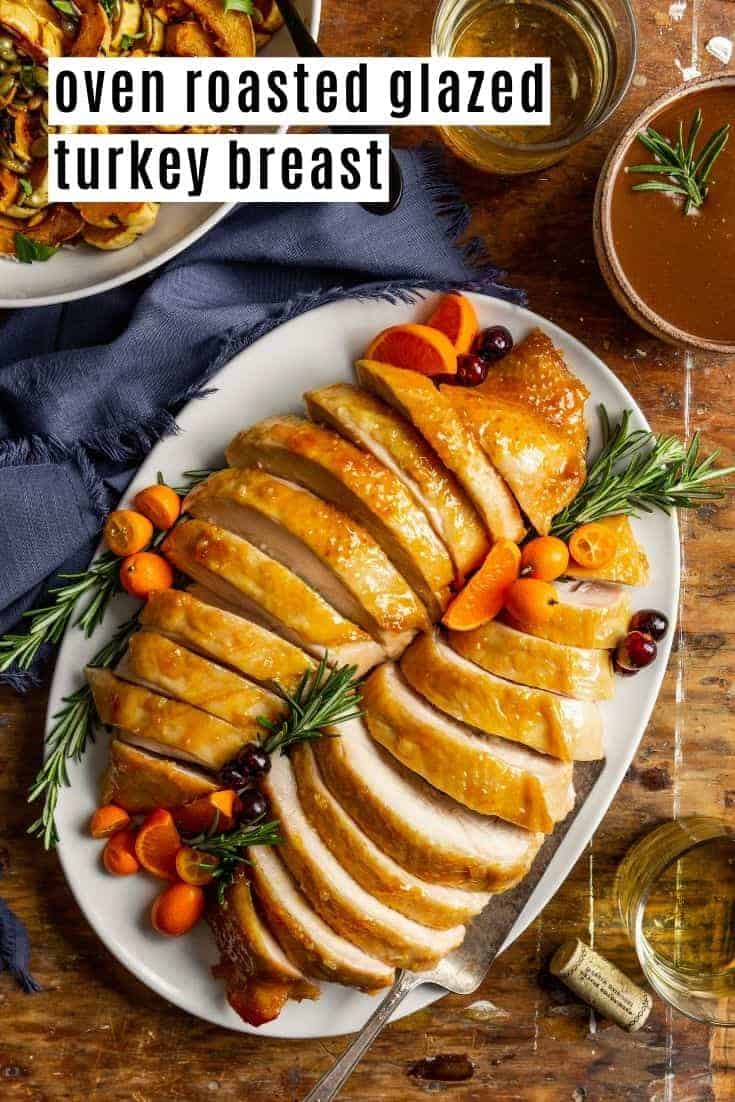
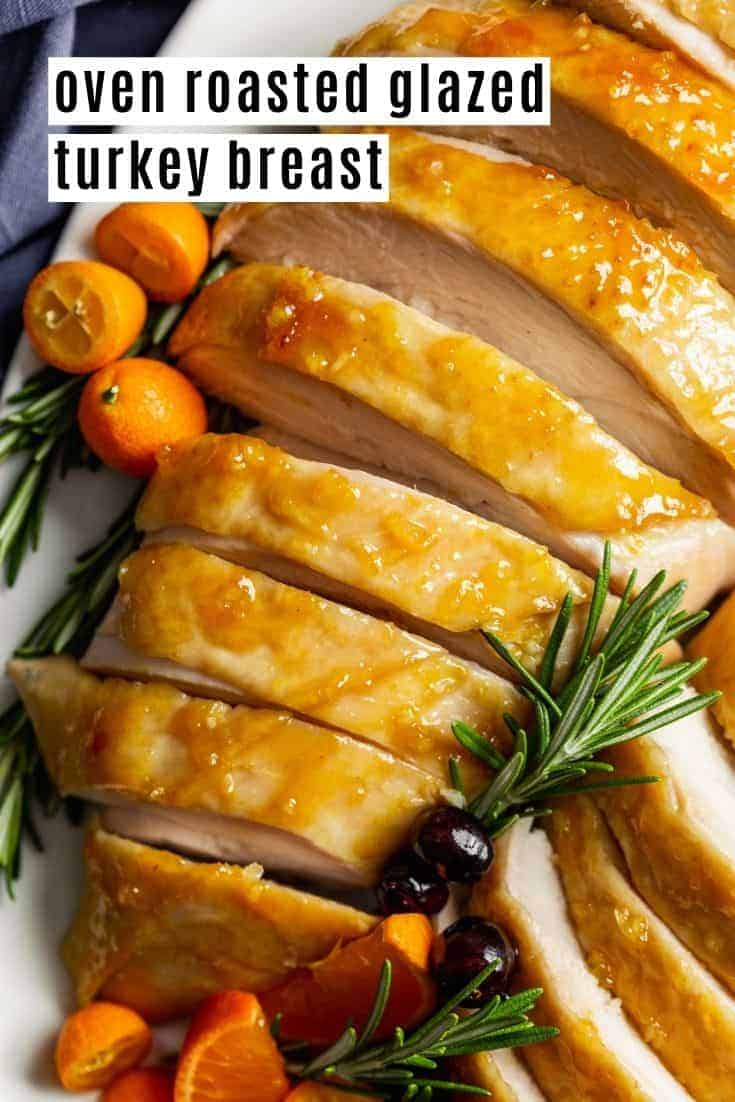
Hi, do you have a preference between the apricot preserves and the sweet orange marmalade?
I Kristina, I prefer orange marmalade! It has more of a “flavor punch”!
Forever making this recipe when it comes to turkey breast! It was so flavorful and so easy to follow. Thanks for the recipe, we loved it!